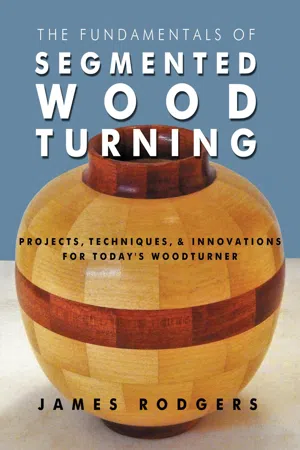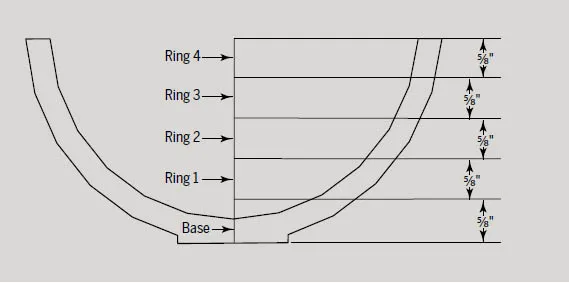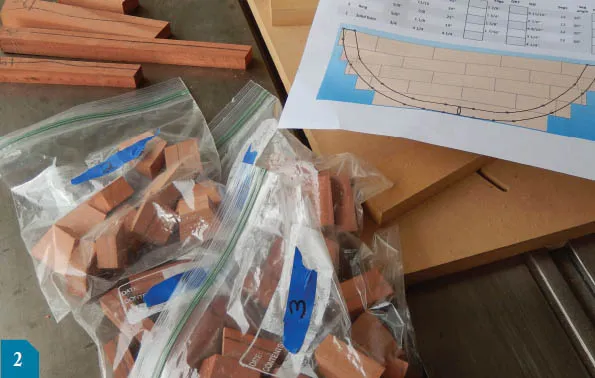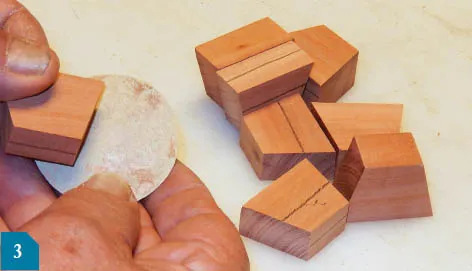
eBook - ePub
The Fundamentals of Segmented Woodturning
Projects, Techniques & Innovations for Today’s Woodturner
- 104 pages
- English
- ePUB (mobile friendly)
- Available on iOS & Android
eBook - ePub
The Fundamentals of Segmented Woodturning
Projects, Techniques & Innovations for Today’s Woodturner
About this book
In The Fundamentals of Segmented Woodturning, professional woodturner and woodturning instructor Jim Rodgers provides the most up-to-date guide for any woodturner trying his hand at segmented woodturning. With an emphasis on visual instruction, The Fundamentals of Segmented Woodturning offers the new segmenter with a simple, accessible introduction to the established practices while providing advanced segmenters with all the new techniques that have emerged due to the growing popularity of the craft.
Starting with the basics, The Fundamentals of Segmented Woodturning covers the essentials of tools, the steps of construction, and critical technique of accurate segment cutting before moving on to ring segmented and open segmented turning. Also covered for today's segmented woodturners are simple design enhancements to dress up any project, a bowl-from-a-board project that utilizes lamination to create mind-blowing designs, and fun techniques for simple and fast segmented pens and vessels that utilize scrap wood and can be completed in a small amount of spare time.
Frequently asked questions
Yes, you can cancel anytime from the Subscription tab in your account settings on the Perlego website. Your subscription will stay active until the end of your current billing period. Learn how to cancel your subscription.
At the moment all of our mobile-responsive ePub books are available to download via the app. Most of our PDFs are also available to download and we're working on making the final remaining ones downloadable now. Learn more here.
Perlego offers two plans: Essential and Complete
- Essential is ideal for learners and professionals who enjoy exploring a wide range of subjects. Access the Essential Library with 800,000+ trusted titles and best-sellers across business, personal growth, and the humanities. Includes unlimited reading time and Standard Read Aloud voice.
- Complete: Perfect for advanced learners and researchers needing full, unrestricted access. Unlock 1.4M+ books across hundreds of subjects, including academic and specialized titles. The Complete Plan also includes advanced features like Premium Read Aloud and Research Assistant.
We are an online textbook subscription service, where you can get access to an entire online library for less than the price of a single book per month. With over 1 million books across 1000+ topics, we’ve got you covered! Learn more here.
Look out for the read-aloud symbol on your next book to see if you can listen to it. The read-aloud tool reads text aloud for you, highlighting the text as it is being read. You can pause it, speed it up and slow it down. Learn more here.
Yes! You can use the Perlego app on both iOS or Android devices to read anytime, anywhere — even offline. Perfect for commutes or when you’re on the go.
Please note we cannot support devices running on iOS 13 and Android 7 or earlier. Learn more about using the app.
Please note we cannot support devices running on iOS 13 and Android 7 or earlier. Learn more about using the app.
Yes, you can access The Fundamentals of Segmented Woodturning by James Rodgers in PDF and/or ePUB format, as well as other popular books in Technology & Engineering & Technical & Manufacturing Trades. We have over one million books available in our catalogue for you to explore.
Information
1 Getting Started, How It’s Done—The Basic Steps
Cautions:
- Always plan ahead, build a cutting plan and follow it.
- Assure that woods used are dry and stable.
- Build grain alignment into your plans.
- Make clean, tight joints.
Start with a simple bowl where you can follow the basic steps of ring segmentation and build a project at the same time.
Make a Drawing
Make a full-scale drawing on graph paper with a wall thickness of at least ½". (Figure 1)

Figure 1
A basic bowl drawing with an interior wall added
Determine the thickness of each ring to be built which may be the thickness of the wood you purchased such as ¾" stock. Add horizontal lines to your drawing to indicate that thickness; number each level. (Figure 2)

Figure 2
Drawing with layers indicated and numbered
For each level mark the widest exterior radius and the narrowest interior radius and record those dimensions on the drawing.(Figure 3)

Figure 3
Drawing with the min/max radii recorded on the drawing
Build a Cut List
Calculate the stock length required by multiplying the maximum radius of each ring level by 2π (3.14 x 2) to get the circumference of that ring; add five additional inches. This additional material allows for the 12 separate ⅛" saw kerfs from cutting the segments, additional material for replacing errors and enough for holding safely while cutting. Start a chart and record this information as the required material length. (Cut List 1)
Cut List 1: Table with stock length calculated and added

Subtract each layer’s minimum radius from its maximum radius and record this as the stock width for that ring. (Cut List 2)
Cut List 2: Table with stock width dimensions added

Calculate the segment edge length by dividing the circumference of each ring (2 π x radius) by the number of segments desired for the project and record this as the segment edge length. In this example we are building a bowl with 12 segments to each ring. (Cut List 3)
Cut List 3: Table with segment included angle calculated and added

Divide the number of segments into 360 (number of degrees in a circle) and record this as the segment’s included angle. (Cut List 4)
Cut List 4: Table with segment included angle calculated and added

There are several software programs on the market that can assist with the vessel drawing, completing the calculations and providing a printable cut list. These programs utilize trigonometry to accurately calculate the dimensions taking into account both vertical and horizontal curvatures that our simple “flat” graph paper cannot do. Check them out; a list of sources is in the appendix.
Cut the Segments
Rip the stock to width and cross cut it to a length to exceed the material length needed from data in the table and number the strips to match each ring number. Also cut a square for the base. (Photo 1)

Stock ripped and cross cut for making segments
Crosscut the segments on your cutting sled and bag them to keep them sorted (the next chapter covers cutting accurate segments in detail). (Photo 2)

Cutting and bagging segments
De-burr each segment being careful not to touch the cut faces. (Photo 3)

Table of contents
- Cover
- Half title
- Title
- Dedication
- Copyright
- Acknowledgements
- Contents
- Preface
- Introduction
- 1. Getting Started—How It’s Done
- 2. Cutting Segments Accurately
- 3. Building a Hollow Vessel
- 4. Simple Design Enhancements
- 5. Techniques for Making Feature Rings
- 6. Setting Up and Building an Open Segment Vessel
- 7. Bowl from a Board
- 8. Other Ideas—Segmented Pens
- 9. Other Ideas—Transitional Vessels
- Appendix